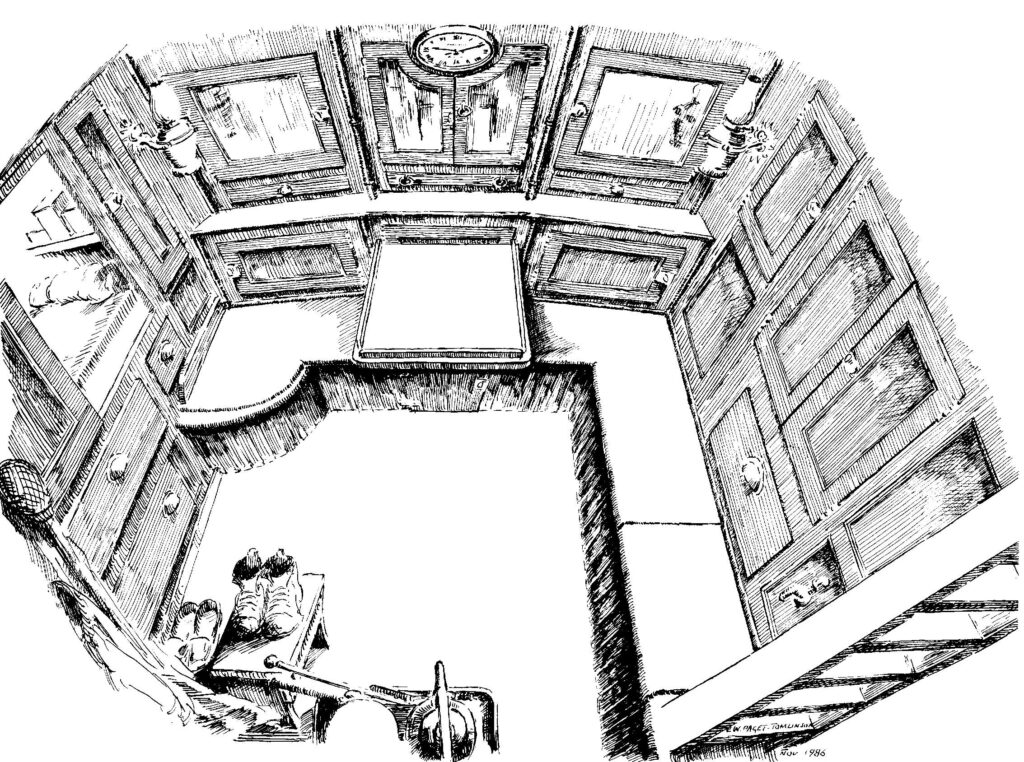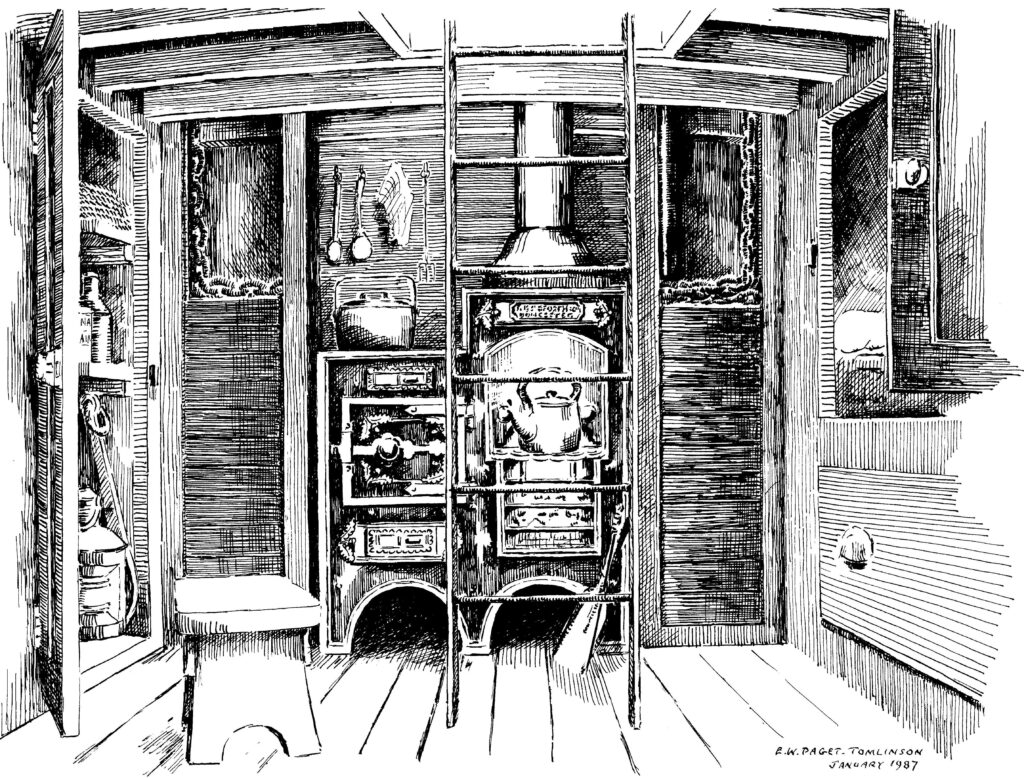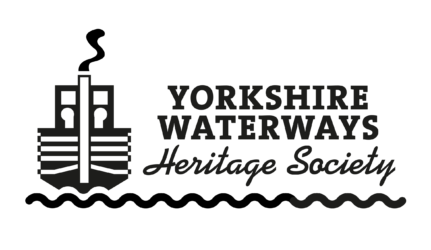Yorkshire’s Watermen Database

Canal Boat Registration - Canal Boats Act, 1877
When campaigners were pushing the Canal Boats Act through parliament in 1877 the improvement of the cramped and often poor quality accommodation found on canal boats had been their major motivation. Particular concern had been expressed for the sleeping arrangements and impact on the moral welfare of women and girls. There were also concerns that children living on a travelling canal boat were not being given a proper education, as would a child living in a house. Registration was mandatory for the owner of any canal boat carrying commercial cargo on which persons slept overnight. After passing inspection the vessel was registered and a certificate issued to the owner which had to be carried onboard the vessel and produced on demand.
The following extraordinary illustrations by the late Edward Paget-Tomlinson appeared in Humber Keels and Keelmen (1988) by Fred Schofield. They are reproduced here with the kind permission of the publisher but our attempts to contact Edward’s widow for her permission have proved unsuccessful.


The left hand image shows the aft cabin of a typical wooden keel drawn from what Paget-Tomlinson described as an “impossible position above the stove” being the only way to show the complete layout. The right hand image shows the forward cabin from the bulkhead separating the cabin from the cargo hold. The canal boat inspector would measure the width, height and length of these cabins to compute the cubic capacity of space available to any family living onboard. He used published tables to establish how many adults and children were then legally allowed to inhabit that amount of space. The cabin dimensions and allowed numbers of persons were entered on both the register and certificate of registration given to the owner.
Creation of a Canal Boat Register for Yorkshire
Society trustee David Scrimgeour was formerly one of the volunteers who worked in the archive at the defunct Yorkshire Waterways Museum. Having been a family historian for many years David found himself helping with enquiries from fellow genealogists searching for their watermen ancestors and the vessels they had worked on the canals and rivers of Yorkshire.
Of the few printed sources available to help, Knottingley historian Ron Gosney’s 1996 transcription Register of Canal Boats for Goole Registration Authority was the most informative. Working keels with accommodation had to be inspected and registered following the Canal Boats Act of 1877. Listing 792 vessel registrations between 1878 and 1898 by name, Ron’s document showed owners and masters with changes made since first registration. Great information for a genealogist but it was a nightmare to search through all 35 pages for names of keels and keelmen. Perhaps there would be an easier way to make the registers searchable?
Prompted to see what other registers might exist it was discovered that registers for Hull, York, Leeds, Bradford, Sheffield, Huddersfield, Doncaster and Wakefield have all survived to some extent. Reference to registrations was also found for Mirfield in local authority minutes allowing partial recreation of the Mirfield register. Several archive visits later and the surviving registers had all been photographed. After many months of transcription, the known registration entries had been increased to just under 3,000. Further work is expected to add approximately 500 more registration records to the database which has been donated to the Society.
Observations on Yorkshire's Canal Boat Registers
The typical registration entry for a Humber keel includes much information considered “meat and drink” to the curious genealogist. In particular the keel owners name and address is recorded although the master, if a different person, might only show a name. The keel’s name is recorded together with planned routes, likely cargoes, how she would propelled, how many cabins she had together with dimensions and the number of persons allowed to sleep onboard.
Sue Wilkes in Tracing your canal ancestors. A guide for family historians had mentioned, almost as an aside, that the registers “if kept accurately” might contain changes of vessel ownership, master and boat name. From reading these registers for transcription it has been possible to gain an impression of how carefully they had been completed and how well they were kept up to date.

- Initials rather than full first names are often used providing a challenge to the genealogist.
- Where the master was not also the owner, his address was usually omitted.
- Changes of master were seldom advised to the registration authority.
- The sale of a vessel and its re-registration with a new authority more convenient to the new owner was rarely advised to the old authority in a timely manner.
- Scrapping of vessels was rarely advised at the time but tended to be recorded years after the event.
- Some “observations” by the canal boat inspector class as “nuggets” which have the potential to add much colour to family history research.
- Unexpected information may be found, for example, when and where a vessel was built.
- Other documents – correspondence and registration certificates – are rare but may be found.
- “Memoranda of change” turn what was a point in time record for a vessel into its history through time.
Canal Boat Register versus the census
For centuries, Yorkshire’s watermen had earned their living navigating their Humber keels over the county’s canals, rivers and the Humber estuary to the ports of Hull and Goole. A key aim of this research project was to discover how canal boat registers could help illuminate the lives of those hard working people by complementing information already available from the census.
Two levels of comparison between census data and canal boat registrations were undertaken: (a) keels in the 1881 census were matched with the registrations recorded before that census day and (b) the registrations were fully incorporated into detailed research into twenty watermen families.
This study has confirmed that if a canal boat registration can be identified it will add significantly to what might have been found in any census record. As well as information about the vessel – name, usual cargo, usual route, means of propulsion, number and size of cabins – the registers provide names and addresses of keel owners and masters. In particular, it was discovered that “memoranda of change” to ownership, vessel names and masters have turned a point in time registration record into a more valuable vessel history.
Examples were found of keels, keel ownership and keel masters which would have remained invisible to the family historian without the canal boat registers.
Access the Yorkshire's Watermen canal boat registration database
Feel free to dive straight in to have a look at the database which is being made available to browse on an “as is” basis.
Alternatively if you want a little bit of reassurance before you dip your toe in the canal, so to speak, click here, and you’ll be shown what to expect.
Please take a moment to give us some feedback on your use of the database using the form below. You have become one of the earliest users of the register and we would value your comments to help us make improvements.
